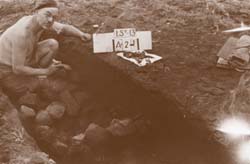
 |
Professor T. Barton Akeley (Olivet College) excavating an Illinois roasting pit (Feature A-21) at the Zimmerman site, 1947. |
Archaeologists learn about human cultures by studying the material remains left behind by peoples of the past. The archaeologist's goal is to gain an understanding of past cultures by developing scientific theories that explain how cultures functioned as integrated systems and why they changed through time. One value of archaeology is its unique capacity to examine the evolution of cultures over long spans of time, ranging from hundreds to thousands of years. Archaeology is also of value to particular cultures or ethnic groups that wish to trace their cultural heritage from the present time back into the distant past.
Culture
Human cultures are complex systems that have several interacting components. The economic component corresponds with how people produce food and earn a living (the Economy and Technology sections of this module). The social component relates to how people interact with one another (the Society section of this module). The ideological component includes the ideas people have about how the universe works and their place within it, including their beliefs about supernatural powers (the Beliefs and Art and Music sections of this module). Archaeologists are interested in all aspects of culture and they develop theories relating to each component based on the material remains they recover from archaeological sites.
Materials
The material remains of interest to archaeologists include artifacts, cultural debris, and the structures or facilities where human activities took place. Artifacts are objects created or modified by people for use as weapons, tools, utensils, containers, ornaments, and so on. Examples of artifacts found at Illinois archaeological sites include projectile points made of chipped stone, hoe blades made of animal bones, spoons made of freshwater mussel shells, pottery vessels made of baked clay, and engraved gorgets made of marine snail shells.
Cultural debris includes byproducts of artifact manufacture, such as chipped-stone flakes, as well as residues of food consumption, like animal bones, mussel shells, and plant remains. Debris from artifact manufacture is of interest because it often provides clues about how artifacts were made. Food residue is important because it indicates how people interacted with their natural environment and what kinds of foods they ate.
Facilities are structures or other special places where people conduct certain kinds of activities. Only in rare circumstances are facilities preserved intact; archaeologists usually encounter only the incomplete traces of facilities, called features, which are preserved below the ground surface. Features commonly found in Illinois archaeological sites include the floors of houses in which people lived, the sub-floor pits in which people stored corn and other plant foods, and the graves in which they buried the dead.
Fieldwork
Archaeologists obtain artifacts, cultural debris, and information on human facilities by conducting fieldwork at archaeological sites. In Illinois, sites of interest to archaeologists include earthen mounds built by prehistoric American Indian cultures (Cahokia site), villages occupied by the Illinois Indians and other historic tribes (Zimmerman site), French forts (Fort de Chartres), and historic homes (Abraham Lincoln home, Springfield). Archaeological fieldwork often involves mapping the site, collecting artifacts exposed on the ground surface, and conducting controlled excavations designed to maximize the recovery of artifacts and other materials.
Analysis
At the end of the field season, the archaeologist returns to the laboratory to process and analyze the collections. Analysis is often done with the help of various specialists, including experts in the examination of pottery and other kinds of artifacts, as well as scientists who specialize in the identification of animal bones, shells, and plant remains. Upon completion of the analysis, the archaeologist prepares a written report to share the results of his or her investigation with the world.
Curation
The collections themselves are carefully labeled and stored at a museum curation facility such as the Illinois State Museum's Research and Collection Center in Springfield. Museum collections are invaluable material records of past human cultures. They provide artifacts and other objects needed to create museum displays. They also serve the needs of museum researchers who wish to improve our understanding of past cultures by analyzing existing collections using new methods and techniques.![]()
|
|
Copyright © 2000 Illinois State Museum